American Stories is the product of several years of preparation, during which the curators planned the exhibition’s scope and narrative, negotiated loans and decided which works from the Met’s collection to include, wrote catalogue essays, and envisioned—at least generally—the arrangement of paintings in the galleries. The works are presented in four chronological groups, allowing visitors to observe the development of painting styles and story-telling devices over time, from portraits of the era of the Revolution to Ashcan pictures of the early twentieth century. Within each section, paintings appear in pairs or groups that encourage visitors to discover their shared themes. Consider, for example, this sequence of interior scenes painted in the years following the Civil War:
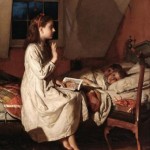 |
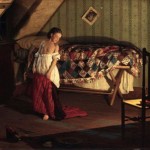 |
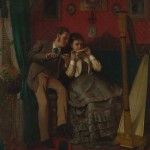 |
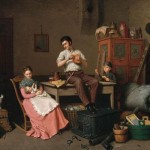 |
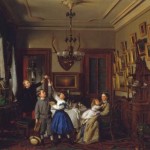 |
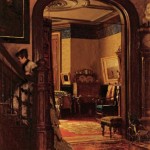 |
Above: Seymour Joseph Guy (American, 1824–1910), Story of Golden Locks, ca. 1870; Seymour Joseph Guy, Making a Train, 1867; John George Brown (American, 1831–1913), The Music Lesson, 1870; Henry Mosler (American, 1841–1920), Just Moved, 1870; Seymour Joseph Guy, The Contest for the Bouquet: The Family of Robert Gordon in Their New York Dining-Room, 1866; Eastman Johnson (American, 1824–1906), Not at Home (An Interior of the Artist’s House), ca. 1873.
When you visit the exhibition in person, you’ll find these six paintings on a single wall within the third section, Stories of War and Reconciliation, 1860–1877. Each painting offers a glimpse of daily life inside the home of a family with children or young people (notice the stroller at the far right in Eastman Johnson’s Not at Home). This group of works tells a powerful story about the ways in which post–Civil War Americans, who had endured more than four years of horror and hardship, sought solace in the domestic realm, and how artists depicted that aspect of the process of national healing. It also reveals how American artists and art patrons looked to children as symbols of promise, and of the innocence that the war-ravaged nation was striving to recapture.
Careful curatorial planning dictated which loans would be sought, but in some cases discoveries about the relationships among works emerged during the process of installation. Take a look at this particular sequence, for example:
 |
 |
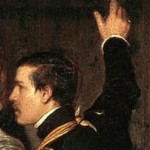 |
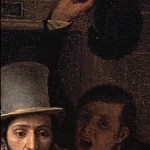 |
 |
 |
Details from: George Caleb Bingham (American, 1811–1879), The Jolly Flatboatmen, 1846; Charles Deas (American, 1818–1867), The Death Struggle, 1845; Richard Caton Woodville (American, 1825–1855),
Old ‘76 and Young ‘48, 1849; Richard Caton Woodville, War News from Mexico, 1848; Richard Caton Woodville, Politics in an Oyster House, 1848; Charles Felix Blauvelt (American, 1824–1900), A German Immigrant Inquiring His Way, 1855.
These paintings are seen in relation to one another in the second section, Stories for the Public, 1830–1860. The six works were all painted between 1845 and 1855, and three are by Richard Caton Woodville, so they already formed a natural group. As the installation proceeded, we noticed that each also features a male figure with raised hands and arms. This recurring motif makes no particular art historical point, but such emphatic, theatrical gestures are typical of the narrative clarity preferred by artists and audiences of the antebellum period. Perhaps most significant, this fortuitous sequence adds a dynamic and pleasing visual punch in the galleries.
Another grouping involves two paintings that share similar and rather spectacular frames. In the fourth section of the exhibition, Cosmopolitan and Candid Stories, 1877–1915, the following works are placed on opposite sides of a doorway:
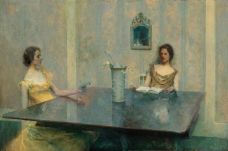 |
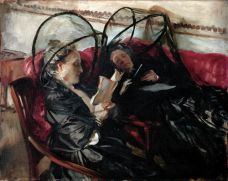 |
Above: Thomas Wilmer Dewing (American, 1851–1938), A Reading, 1897; John Singer Sargent (American, 1856–1925), Mosquito Nets, 1908.
Thomas Wilmer Dewing’s A Reading, on loan from the Smithsonian American Art Museum, is enhanced by a frame that was designed by Stanford White, of the architectural firm McKim, Mead & White, which flourished about 1900. Dewing was a close friend of White’s, and it is not unusual to see his paintings in White-designed frames, which frequently feature a distinctive grille pattern. (See a detail image of a similar frame—in this case, on an example from our permanent collection—designed by Stanford White.) John Singer Sargent’s Mosquito Nets, lent by the Detroit Institute of Arts, is also set off by a frame based on one of Stanford White’s designs. The similarity of the two frames underscores the connection between the theme of the two paintings: ladies at leisure—reading and listening to stories—in elegant interiors.
As the above comparisons illustrate, the American Stories galleries are filled with paintings that speak to each other in fascinating and sometimes unexpected ways. Each visitor is bound to notice something different, so I welcome you to share your observations and discoveries here.
—Katie Steiner
Tags: Charles_Deas, Charles_Felix_Blauvelt, civil_war, Eastman_Johnson, frame, George_Caleb_Bingham, Henry_Mosler, John_George_Brown, John_Singer_Sargent, Richard_Caton_Woodville, Seymour_Joseph_Guy, Stanford_White, Thomas_Wilmer_Dewing

